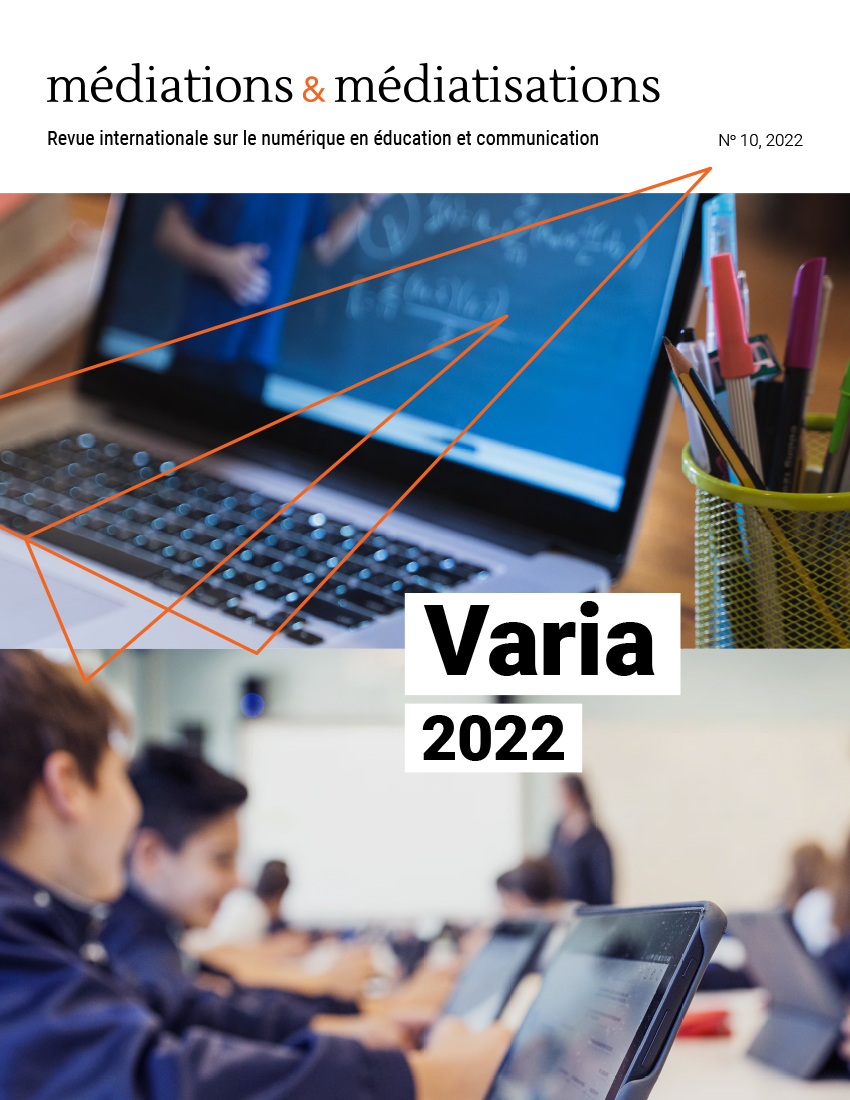Instrumenter l’apprentissage autodirigé avec le numérique : au-delà des environnements personnels d’apprentissage
##plugins.themes.bootstrap3.article.main##
Resumo
L’autoformation sur Internet a été longtemps étudiée au prisme de la notion d’apprentissage autodirigé. Sur le plan technologique, c’est initialement par la notion d’environnement personnel d’apprentissage (EPA) que l’agentivité des apprenants dans les pratiques d’autoformation a été étudiée. Ces écosystèmes d’outils digitaux permettent de structurer des apprentissages en dehors de tout cadre institué. La manière d’appréhender l’instrumentation du butinage pourrait néanmoins évoluer dans les années à venir au-delà du seul périmètre des EPA, et ce, à au moins deux titres. En premier lieu apparaissent des plateformes consacrées à l’apprentissage autodirigé en ligne, réunissant en un seul endroit des fonctionnalités auparavant dispersées au sein d’une palette d’outils génériques. En second lieu, les normes du e-learning évoluent pour prendre en compte des apprentissages informels réalisés en dehors de dispositifs de cours en ligne. Ce changement de paradigme est symbolisé par le remplacement progressif de la norme SCORM par la norme xAPI. Dans cette contribution, nous présentons cette évolution tant des plateformes que de la manière de considérer les analytiques de l’apprentissage. Nous débattons de la signification de cette évolution en termes de manière de penser, sur le plan technologique, l’apprentissage en ligne autodirigé.
Downloads
##plugins.themes.bootstrap3.article.details##
Referências
Brusilovsky, P. (2001). Adaptive hypermedia. User modeling and user-adapted interaction, 11(1), 87-110.
Chatti, M. A., Jarke, M., et Frosch-Wilke, D. (2007). The future of e-learning: a shift to knowledge networking and social software. International journal of knowledge and learning, 3(4-5), 404-420.
Cisel, M. (2017). Le MOOC vu comme un projet d’apprentissage. Education & Formation. e307-02
Cisel, M. (2019, Juin). Analyser la disparition de la gratuité dans les MOOC au prisme des buts d'accomplissement. Dans les Actes de la conférence Environnements Informatiques pour l'Apprentissage Humain 2019 (p. 13-24). Paris. https://eiah2019.sciencesconf.org/data/pages/ActesEIAH2019_V4.0.pdf
Clarà, M., et Barberà, E. (2014). Three problems with the connectivist conception of learning. Journal of Computer Assisted Learning, 30(3), 197-206.
Fini, A. (2009). The technological dimension of a massive open online course: The case of the CCK08 course tools. International Review of Research in Open and Distributed Learning, 10(5). https://doi.org/10.19173/irrodl.v10i5.643
Flanagan, B., et Ogata, H. (2018). Learning analytics infrastructure for seamless learning. Dans Companion proceedings 8th international conference on learning analytics & knowledge (LAK18). Association for Computing Machinery (ACM).
Jézégou, A. (2008). Apprentissage autodirigé et formation à distance. Distances et savoirs, 6(3), 343-364.
Jézégou, A. (2018). Diriger soi-même ses activités d'apprentissage par et dans un Mooc de type connectiviste : recherche conduite auprès de participants au C-Mooc francophone «Itypa 1». Journal of Distance Education/Revue de l'Éducation à Distance. https://www.ijede.ca/index.php/jde/article/view/868
Klamma, R., Chatti, M. A., Duval, E., Hummel, H., Hvannberg, E. T., Kravcik, M., Effie Law, L.-C., Naeve, A. et Scott, P. (2007). Social software for life-long learning. Journal of Educational Technology et Society, 10(3), 72-83.
Kop, R., et Hill, A. (2008). Connectivism: Learning theory of the future or vestige of the past? International Review of Research in Open and Distributed Learning, 9(3), 1-13.
Long, H. (1989). Self-directed learning – emerging theory and practice. University of Oklahoma, Norman.
Manso-Vázquez, M., Caeiro-Rodríguez, M., & Llamas-Nistal, M. (2018). An xAPI application profile to monitor self- regulated learning strategies. IEEE Access, 6, 42467-42481. https://doi.org/10.1109/ACCESS.2018.2860519
Plantard, P. (2014). Anthropologie des usages du numérique (HDR, Université de Nantes).
Quentin, I., et Condé, J. (2016). Les rôles endossés par les apprenants les plus actifs dans un forum de MOOC : le cas d’ItyPA 2. Distances et médiations des savoirs. Distance and Mediation of Knowledge, (15). https://doi.org/10.4000/dms.1567
Radford, A. W., Robles, J., Cataylo, S., Horn, L., Thornton, J., et Whitfield, K. (2014). The employer potential of MOOCs: A mixed-methods study of human resource professionals’ thinking on MOOCs. International Review of Research in Open and Distributed Learning, 15(5), 1-25. https://doi.org/10.19173/irrodl.v15i5.1842
Shapiro, M. A. et Park, H. W. (2015). More than entertainment: YouTube and public responses to the science of global warming and climate change. Social Science Information, 54(1), 115-145. https://doi.org/10.1177%2F0539018414554730
Siemens, G., et Conole, G. (2011). Connectivism: Design and delivery of social networked learning. International Review of Research in Open andDistance Learning, 12(3). https://doi.org/10.19173/irrodl.v12i3.994
Song, L., et Hill, J. R. (2007). A conceptual model for understanding self-directed learning in online environments. Journal of Interactive Online Learning, 6(1), 27-42.
Tough, A. M. (1971). The adult’s learning projects: a fresh approach to theory and practice in adult learning. Ontario Institute for Studies in education.
Welbourne, D. J., et Grant, W. J. (2016). Science communication on YouTube: Factors that affect channel and video popularity. Public Understanding of Science, 25(6), 706-718. https://doi.org/10.1177%2F0963662515572068

